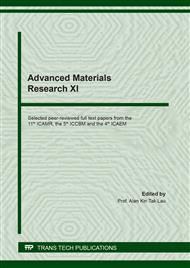[1]
Ren Y, Shen Y, Lin Y, et al. Direct observation of lithium dendrites inside garnet-type lithium-ion solid electrolyte. Electrochemistry Communications, 2015, 57:27-30.
DOI: 10.1016/j.elecom.2015.05.001
Google Scholar
[2]
Liu K, Zhuo D, Lee H W, et al. Extending the Life of Lithium‐Based Rechargeable Batteries by Reaction of Lithium Dendrites with a Novel Silica Nanoparticle Sandwiched Separator. Advanced Materials, 2017, 29(4):1603987.1-1603987.6.
DOI: 10.1002/adma.201603987
Google Scholar
[3]
Yu H C, Ling C, Bhattacharya J, et al. Designing the next generation high capacity battery electrodes. Energy & Environmental ence, 2014, 7(5):1760-1768.
DOI: 10.1039/c3ee43154a
Google Scholar
[4]
Ahmed, Bilal, Anjum, Dalaver H, Gogotsi, Yury et al. Atomic Layer Deposition of SnO2 on MXene for Li-Ion Battery Anodes. Nano energy, 2017, 34:249-256.
DOI: 10.1016/j.nanoen.2017.02.043
Google Scholar
[5]
Yierpan Aierken, Cem Sevik, Oğuz Gülseren, François M. Peeters and Deniz Çakır, MXenes/graphene heterostructures for Li battery applications: a first principles study, Journal of Materials Chemistry A 2018, 6, 2337.
DOI: 10.1039/c7ta09001c
Google Scholar
[6]
Li S, Zheng J, Zuo S, et al. 2D hybrid anode based on SnS nanosheet bonded with graphene to enhance electrochemical performance for lithium-ion batteries. RSC ADVANCES, 2015, 5(58):46941-46946.
DOI: 10.1039/c5ra07292a
Google Scholar
[7]
Zhang K, Kim H J, Shi X, et al. Graphene/Acid Coassisted Synthesis of Ultrathin MoS2 Nanosheets with Outstanding Rate Capability for a Lithium Battery Anode. Inorganic Chemistry, 2013, 52(17):9807-9812.
DOI: 10.1021/ic400735f
Google Scholar
[8]
Shuijing, Sun, et al. Hybrid energy storage mechanisms for sulfur-decorated Ti3C2 MXene anode material for high-rate and long-life sodium-ion batteries. Chemical Engineering Journal, 2019, 366, 460-467.
DOI: 10.1016/j.cej.2019.01.185
Google Scholar
[9]
Guo X, Xie X, Choi S, et al. Sb2O3/MXene(Ti3C2Tx) hybrid anode materials with enhanced performance for sodium-ion batteries. Journal of Materials Chemistry A, 2017, 5, 12445.
Google Scholar
[10]
Li L, Raji A R O, Tour J M. Graphene-wrapped MnO2 -graphene nanoribbons as anode materials for high-performance lithium ion batteries. Advanced Materials, 2013, 25(43):6298-6302.
DOI: 10.1002/adma.201302915
Google Scholar
[11]
First principles methods using CASTEP, Zeitschrift fuer Kristallographie 220(5-6) pp.567-570 (2005).
Google Scholar
[12]
J. P. Perdew, K. Burke, and M. Ernzerhof, Generalized gradient approximation made simple, Phys. Rev. Lett. 77, 3865 (1996).
DOI: 10.1103/physrevlett.77.3865
Google Scholar
[13]
G. Stefan, E. Stephan, and G. Lars, Effect of the damping function in dispersion corrected density functional theory, J. Comput. Chem. 32, 1456 (2011).
Google Scholar


